American philanthropist Julius Rosenwald is best known for his work in the rural South in the early 20th century building schools for African American children. Before his 1917 fund changed the face of education and race in the country, he helped African American communities from coast-to-coast build YMCAs. Of the two dozen facilities Rosenwald funded in fourteen states, three were in Pennsylvania.
Jewish American Philanthropist Julius Rosenwald
Julius Rosenwald was born in Springfield, Illinois in 1862. As was a common path for Jews in America, in lieu of completing high school, he moved to New York City to apprentice in the garment industry. There, he opened a clothing store before moving back to Illinois, but now settling in Chicago.
In 1909, Rosenwald became president of the mail order behemoth Sears, Roebuck and Company. After a working partnership over almost 15 years, he eventually bought out both Roebuck and Sears to become one of the wealthiest men in the United States in the first few decades of the 20th century.
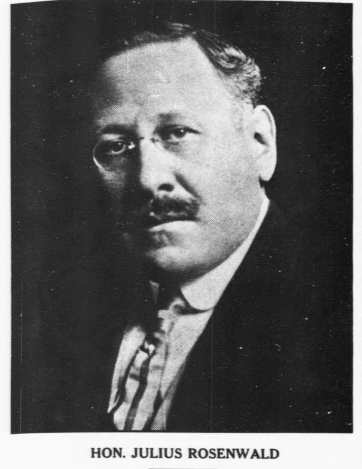
However, Rosenwald did not idly sit by and accumulate vast sums of money. Instead, he viewed his wealth as a burden and sought to use philanthropy as a means of civic stewardship. Hasia Diner refers to him as “The Forgotten Millionaire” in the biography Julius Rosenwald: Repairing the World.
Initially, he focused his generosity on Jewish organizations in Chicago, but it was his friendship with Booker T. Washington, the president of Tuskegee Institute, that began in 1910 that would completely shift the focus of the lion’s share of his philanthropic efforts. Over his lifetime, Julius Rosenwald eventually donated sixty-three million dollars of his wealth, with nearly half of that going directly to African Americans (Mjagkii, 75).
Rosenwald and African American YMCAs
Rosenwald was already a financial supporter of the white YMCA (Young Men’s Christian Association) organizations in Chicago and in 1910, he decided to shift and support the construction of African American YMCAs in order to provide “African-Americans with opportunities for self-help and personal improvement and not with charity” (Mjagkii, 75).
African American YMCAs existed as organizations only as early as 1866-1867, starting in New York City, Charleston, South Carolina, and both Harrisburg and Philadelphia, Pennsylvania (Mjagkii, 18). The organization was first established in London in 1844 and the first U.S. YMCA was founded in Boston in 1851.
Prior to 1900, very few African American YMCAs owned buildings. Between 1866 and 1900 only five were able to own their buildings, those in Norfolk, Richmond, Baltimore, New Haven, and Springfield, Ohio (Mjagkii, 67). Those early African American YMCAs would meet in rented apartments or private residences and rarely had the means to construct a purpose-built YMCA building suited for their programmatic needs.
Rosenwald started by offering a $25,000 donation but specified that it must be for the construction of the African American YMCA building in Chicago. This quickly inspired him to establish a larger building campaign in December 1910 to offer $25,000 to any city in the United States that could raise $75,000 to match.
Within this initial 1910 allocation, Rosenwald funded twelve YMCAs across the country in Washington, D.C., Chicago, Indianapolis, Philadelphia, Kansas City, Cincinnati, Brooklyn, Baltimore, St. Louis, Columbus, New York (Harlem), and Atlanta.
The program was so successful and popular that, following the economic austerity of WWI which hampered the capital campaign fundraising efforts of the communities, Rosenwald offered a second round of funding in 1920 which led to the construction of twelve more purpose built African American YMCAs across the country in Pittsburgh, Denver, Detroit, Los Angeles, Buffalo, Dayton, Montclair, Toledo, Dallas, Youngstown, Orange, and Harrisburg.
Of the 24 African American YMCAs funded by Julius Rosenwald’s grant program, three were in Pennsylvania: Philadelphia’s Christian Street YMCA located at 1724 Christian Street, built in 1914; Pittsburgh’s Centre Avenue YMCA located at 2621 Centre Avenue, and built from 1922-1923; and Harrisburg’s Forster Street YMCA, located at 614-628 Forster Street, built in 1933.
Christian Street YMCA (1914) – 1724 Christian Street, Philadelphia
The first meeting of the Christian Street YMCA, the fourth African American YMCA organization in the United States and the first in Pennsylvania, was held in 1889 at the home of William Still. For the next twenty-five years, the YMCA would meet at private homes and businesses until Rosenwald’s funding made constructing a permanent home possible.
In 1914, the Christian Street YMCA at 1724 Christian Street in Philadelphia opened as the first purpose-built YMCA building in both Philadelphia, and Pennsylvania, for African Americans. Located in the city’s 30th Ward, the Christian Street YMCA quickly became an invaluable community resource for the city’s African American community, supporting both residents whose families had been in the city for generations and those who recently arrived as part of the Great Migration in the 1910s. The building provided lodging, sports facilities, classrooms, and meeting spaces.
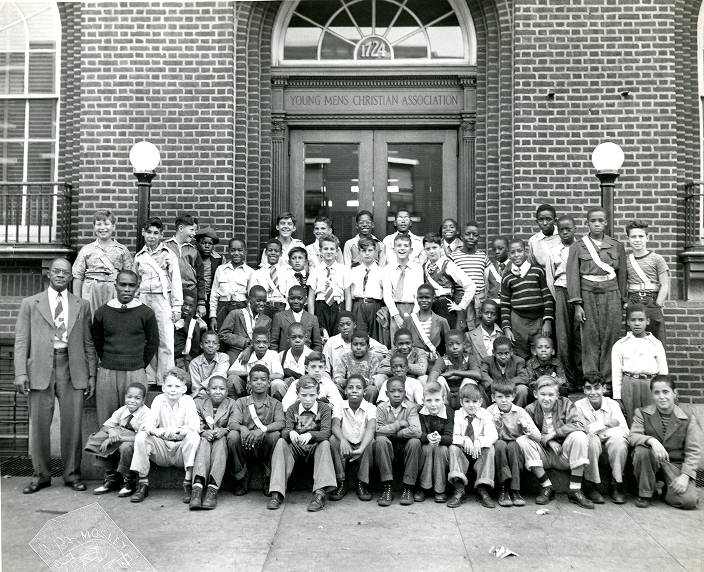
In 1972, the original Christian Street YMCA building was demolished and replaced with a new a modern YMCA building. In 1991, a Pennsylvania Historical Marker commemorating the c. 1914 Christian Street YMCA was dedicated outside of the c. 1974 Christian Street YMCA. The marker text reads:
Opened in 1914, this is the first Black YMCA to have its own building. A social center and meeting place for African-American organizations, it provided recreational and educational opportunities for members of the Black community.
Centre Avenue YMCA (1923) – 2621 Centre Avenue, Pittsburgh (Allegheny County)
While Pittsburgh’s African American YMCA was officially recognized in 1906, the organization originally rented space in a (now demolished) three-story building at 1847 Centre Avenue.
As soon as Rosenwald announced his funding challenge in 1910, the Centre Avenue YMCA leaders quickly organized to raise money for the necessary $75,000 in matching funds to build their own dedicated YMCA for Pittsburgh’s African American community. It took over ten years for the Centre Avenue YMCA to raise the necessary money and they were finally successful in getting Rosenwald’s financial support in the 1920 funding round.
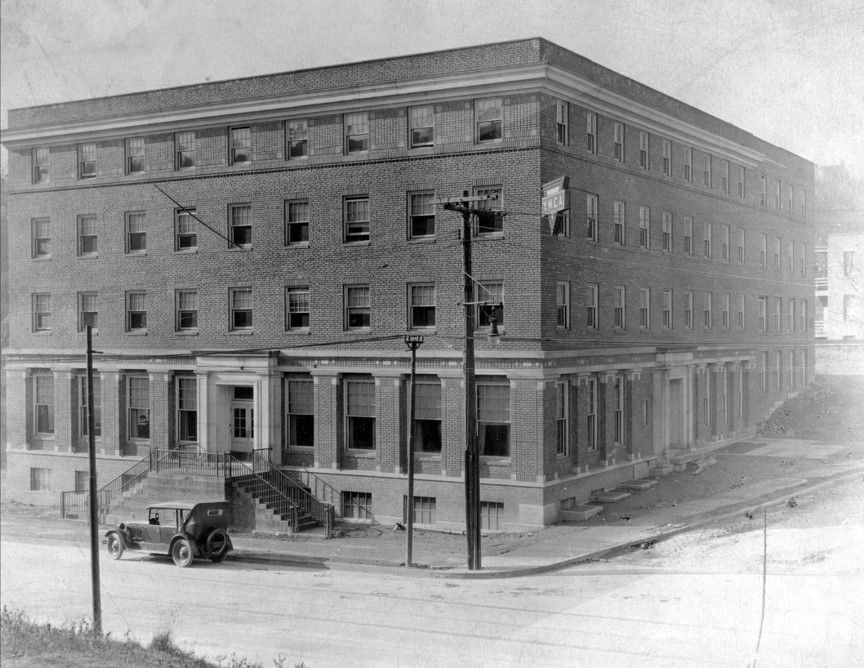
The Centre Avenue YMCA in Pittsburgh is the only purpose built African American YMCA in Pennsylvania still standing today. It was listed in the National Register of Historic Places on November 3, 2021. The Centre Avenue YMCA is PA-SHARE Resource #1987RE00197 and the full National Register nomination is available for all to read in PA-SHARE. It’s rehabilitation – using historic tax credits – is almost complete.
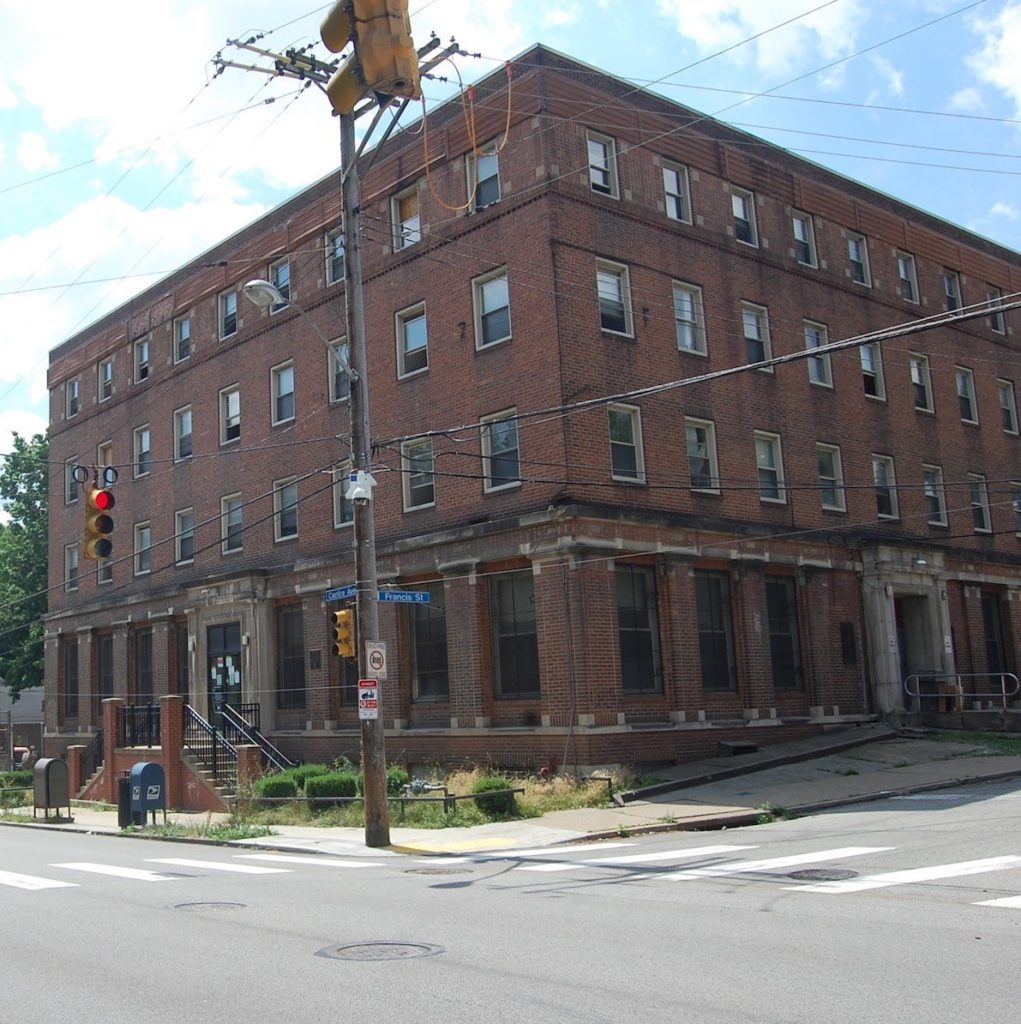
Forster Street YMCA (1933) – 614-628 Forster Street, Harrisburg (Dauphin County)
Harrisburg’s Forster Street YMCA was the last African American YMCA funded by Julius Rosenwald. Built in 1933 in the 600 block of Forster Street, the facility included a swimming pool, gymnasium, dormitories, and restaurant. It was, at one point, the primary center of African American social life in Harrisburg outside of a church.
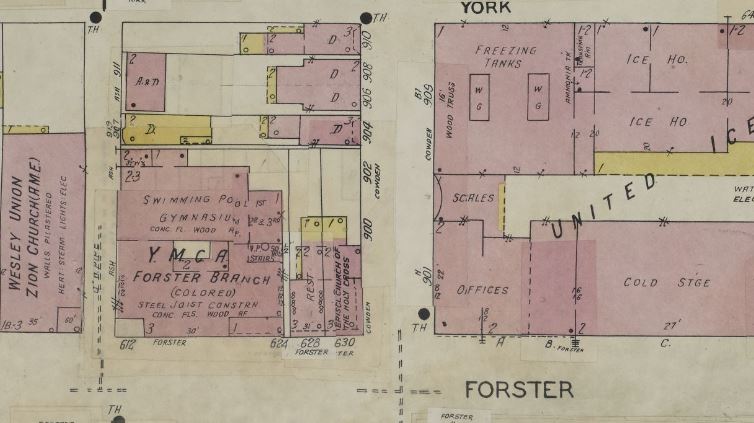
The Forster Street YMCA was only a block away from the Pennsylvania State Capitol building and almost directly across the street from the current location of the Pennsylvania State Archives, the Pennsylvania State Museum, and the Keystone Building (the current home of the PA SHPO offices).
During the era of expansion of the state government office buildings in Harrisburg of the 1960s, the Forster Street YMCA was demolished in 1964 to make way for a new state government building. In 1966, the YMCA association relocated to the Camp Curtin YMCA on Sixth Street in Harrisburg.
Rosenwald Schools and the Rosenwald Schools Study Act of 2021
Julius Rosenwald and Booker T. Washington quickly shifted the philanthropic model that they had developed together for the African American YMCA buildings to address the woeful inadequacy of schools for African Americans in the South. Rosenwald first became keenly aware of the plight of the barely habitable spaces used to educate African American children in the rural South after traveling Alabama to visit Booker T. Washington at Tuskegee Institute.
After funding YMCAs across the country, Rosenwald’s focused his philanthropic work on the Rosenwald Fund, established in 1917, as his matching grant program to construct schools for African Americans in the rural South. Between 1917 and 1932, when he died, Julius Rosenwald funded, in part, the construction of more than 5,000 schoolhouses for African Americans in small towns all across in the South.
In the last two decades, Rosenwald Schools have become a hot topic in Architectural History and Historic Preservation. In 2002, the National Trust for Historic Preservation placed the Rosenwald Schools on its 11 Most Endangered Historic Places list and ever since states in the South have begun to rediscover these buildings that had been largely forgotten in the second half of the 20th century.
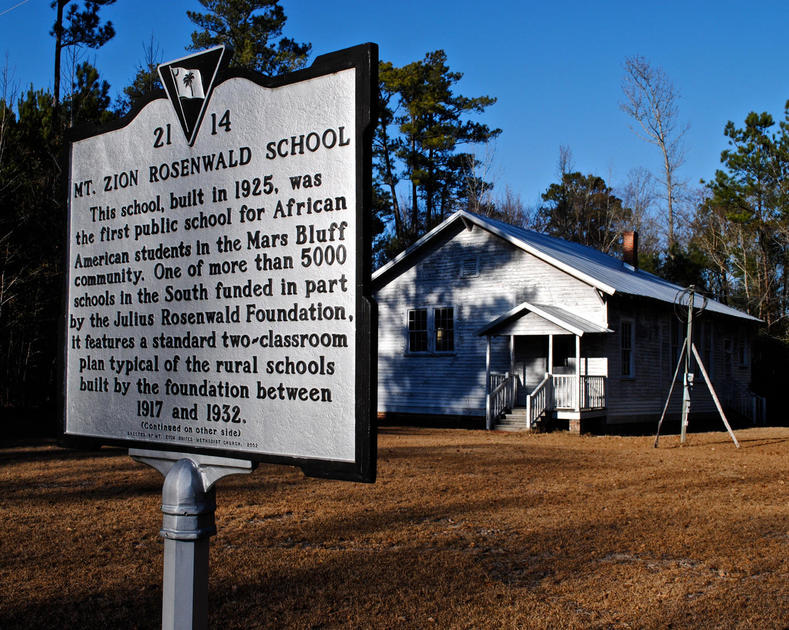
Since the late 2010s, national organizations like the National Trust for Historic Preservation and many non-profit preservation advocacy organizations in the south have focused conferences, resource surveys, Multiple Property Documentation Forms (MPDFs), and statewide university databases for these otherwise plain and often derelict and abandoned school buildings that had been overlooked for decades.
On January 13, 2021, the Rosenwald Schools Study Act was signed into law. The Act, also known as Public Law 116-336, will require “the Secretary of the Interior to conduct a special resource study of the sites associated with the life and legacy of the noted American philanthropist and business executive Julius Rosenwald, with a special focus on the Rosenwald Schools, and for other purposes”. According to the definitions in the text of the Act, “Rosenwald School” means any of the 5,357 schools and related buildings constructed in 15 southern States during the period of 1912 through 1932 by the philanthropy of Julius Rosenwald” and “study area” means the sites associated with the life and legacy of Julius Rosenwald.
Rosenwald’s YMCA Legacy
The twenty-four African American YMCAs Rosenwald funded remain largely unstudied. Unlike the school buildings which Rosenwald funded in the rural South, these sites existed mostly north of the Mason-Dixon line, in the west, and in urban areas often hit hard during 20th century urban renewal so few survive. Most books on Julius Rosenwald’s life and his philanthropic work focus on the Rosenwald Schools of the rural South and his 1917 Rosenwald Fund; his work with African American YMCA construction is limited to a few pages.
The untold story is Rosenwald’s philanthropy related to the construction of YMCAs by and for African American communities. His deep friendship with Booker T. Washington from 1910 to 1915, when Washington died, helped launch Rosenwald’s national YMCA campaign. When compared to his school campaign, the numbers may be small at only two dozen properties but the investment was incredibly impactful to those twenty-four African American communities.
Rosenwald’s YMCA work laid the foundation for his more well-known endeavor, the Rosenwald Fund and Rosenwald Schools. He successfully expanded the funding model he tried and tested in the 1910s and 1920s with YMCAs to empowered thousands of African American communities across the South to sponsor and build their own schools.
Stephanie Deutsch closes the epilogue of her book You Need a Schoolhouse: Booker T. Washington, Julius Rosenwald, and the Building of Schools for the Segregated South with this thought:
“Neither Washington nor Julius Rosenwald confronted segregation directly, but by building up significant numbers of men and women, they did help pave the way for a more equal and fair society…It must have been tempting to give in to anger, to lose heart and despair, but so many-Booker T. Washington, Martin Luther King, Jr., John Lewis, Carlotta Walls LaNier, Dorothy Height, Franklin Warner- the vast majority of African-Americans, did not. Like Julius Rosenwald, they took faithful steps in trying times without knowing just where they would lead” (Deutsch, 173).
Further reading about Julius Rosenwald and YMCAs:
Ascoli, Peter M. Julius Rosenwald: The Man Who Built Sears, Roebuck and Advanced the Cause of Black Education in the American South (Philanthropic and Nonprofit Studies). Bloomington, Indiana: Indiana University Press, 2015. (Ascoli is the grandson of Julius Rosenwald)
Deutsch, Stephanie. You Need a Schoolhouse: Booker T. Washington, Julius Rosenwald, and the Building of Schools for the Segregated South. Evanston, Illinois: Northwestern University Press, 2011.
Diner, Hasia R., Julius Rosenwald: Repairing the World. New Haven: Yale University Press, 2017.
Feiler, Andrew. A Better Life for Their Children: Julius Rosenwald, Booker T. Washington, and the 4,978 Schools That Changed America. Athens: University of Georgia Press, 2021.
Hoffschwelle, Mary S. The Rosenwald Schools of the American South (New Perspectives on the History of the South). Gainesville: University Press of Florida, 2014.
Kempner, Aviva. Rosenwald: A Remarkable Story of a Jewish Partnership with African American Communities, 2015. http://rosenwaldfilm.org/.
Lupkin, Paula. Manhood Factories: YMCA Architecture and the Making of Modern Urban Culture. Architecture, Landscape, and American Culture Series. Minneapolis: University of Minnesota Press, 2010.
Mjagkij, Nina. Light in the Darkness: African Americans and the YMCA, 1852-1946. Lexington: The University Press of Kentucky, 1994.
Comment Policy
PHMC welcomes and encourages topic-related comments on this blog. PHMC reserves the right to remove comments that in PHMC’s discretion do not follow participation guidelines.
Commenters and Comments shall be related to the blog post topic and respectful of others who use this site.
Commenters and Comments shall not: use language that is offensive, inflammatory or provocative (this includes, but is not limited to, using profanity, obscene, or vulgar comments); disparage other commenters or people; condone illegal activity; identify the location of known or suspected archeological sites; post personal information in comments such as addresses, phone numbers, e-mail addresses or other contact details, which may relate to you or other individuals; impersonate or falsely claim to represent a person or an organization; make any commercial endorsement or promotion of any product, service or publication.
If you would like to comment on other topics not related to this blog post but related to PHMC, please fill out the PHMC Contact Us Form.

What a great and informative article. While I am sorry that Harrisburg did not preserve its African American YMCA, I am grateful that that Pittsburgh did so and that the building will continue to illustrate this important story in American history. Thanks for including all the images!
Hi Jenna. I am a friend of your Mom’s and your grabdpop. Your Mon shared with me what you had researched and written about. I just finished reading your writings and it was very interesting. You have a way of explaining that is not only enjoyable but so easy to read and understand. Good luck with all you do. I am looking forward to more of your articles. Take care, Patty Davis
THANK YOU !